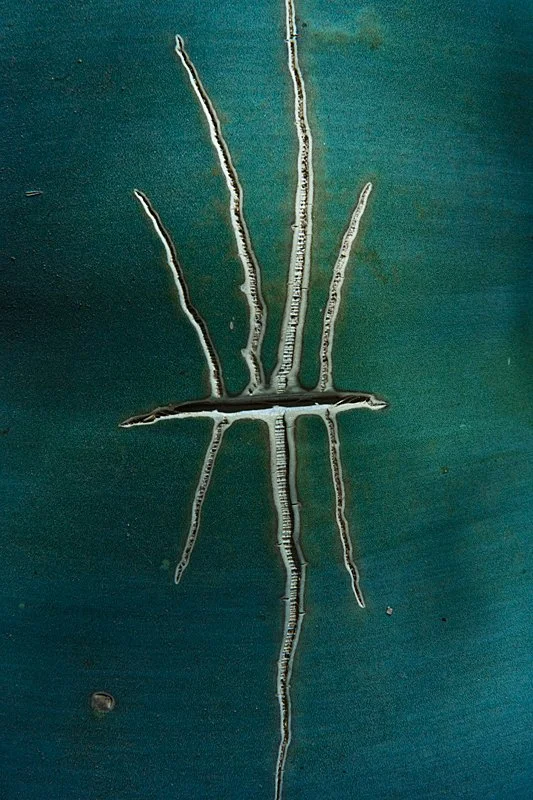Desert Dialogues
Abstract expressionist photographs of plants found in the Sonoran Desert
“Rune” ©2007 by Ken McElrath. All rights reserved.
Perhaps in response to being immersed in the world of commercial design for over 20 years—where nearly all images must be easily perceived and laden with obvious didactic message—at the time I made the Desert Dialogues series I was paying very little attention to direct representation and instead wanted to make images that invited a different kind of viewer engagement.
Though I was still engrossed in commercial art each day of my business career, this fine art series provided a much needed creative outlet while providing me with the opportunity to establish a meditative “conversation” of sorts with the subject matter of desert flora.
Choosing desert plants made sense to me at the time. I had recently moved my family from San Francisco to Phoenix after my mother contracted Alzheimer’s disease and my father was diagnosed with cancer. We moved to be closer to them in their final years. The many ages-old allegories of the “desert experience” of isolation and suffering reflected my own experience in Phoenix at the time. So a major reason for exploring the desert was to process my own feelings about not wanting to remain there, physically or spiritually. This series became a search for internal resolution by achieving formal resolution, a process of exploring the paradox of joy inside tears, beauty inside the sublime. As such, it exhibits a creative discourse with desert forms that others may engage in their own ways.
To achieve my goals, I spent a tremendous amount of time in observation of these plants. The botanical and geographic features of the broader Sonoran desert region include plentiful patterns, lines, textures and colors with marvelous opportunities for formal exploration. I traveled to several different locations to find more diverse subject matter, including:
Cabeza Prieta National Wildlife Refuge and Organ Pipe Cactus National Monument, located in southern Arizona near the Mexico border
Saguaro National Park and The Arizona-Sonora Desert Museum located near Tucson, Arizona
The Desert Botanical Garden located in Phoenix, Arizona
The Pinacate and Grand Altar Desert Biosphere Reserve located outside of Puerto Peñasco, Sonora, Mexico (including where the desert meets the Sea of Cortez in Puerto Peñasco, Sonora).
While the plants didn’t speak to me audibly (I’m not crazy yet, I think) my times of contemplation did help me hear voices within myself that had been silenced for years by my own workaholic tendencies.
I did not choose mimetic representation for easy recognition and consumption (“Oh, that’s a pretty picture of a saguaro” or, “Study of Palo Verde from Phoenix, Arizona”). But photography is a mimetic medium: what you see through the lens is something that actually existed in nature. I like that, and strove to show viewers exactly what I saw in my camera at a particular place and time. However, having a dialog with these images does not require an accurate interpretation of the subject matter by the viewer. Instead, each image presents a very particular point of view — and engagement with formal elements for personal consideration and contemplation. The interpretation of the viewer will most likely be altogether unique and different than my own, and this is perfectly acceptable—even desirable.
I believe that art can be an effective mirror for what is going on inside of each viewer. Some folks see pain reflected, while others see joy. Some see anthopomorphism. Others see landscapes or even space-scapes. This is the wonderful thing about abstraction. Using formal techniques to express my own feelings does not necessarily limit how the work can be enjoyed by others. My hope is that viewers will be assisted on their own paths toward resolution.
When I began the series, I had a strong sense that my particular desert experience would soon be over. So I had a sense of urgency to dive into it and experience it for what it was before it was gone. My mother passed away from aggressive Alzheimers in early 2007. In the same year, my design business nearly went bankrupt due to the criminal behavior of one of my clients, who was put into prison before paying a rather large bill. Despite the sufferings of my desert time, through creating Desert Dialogues I found beauty and healing amid the pain, isolation, and harshness of that place and time in my life.
Many thanks go to my wife, Donna, for traveling, camping, and carrying equipment with me on many of these excursions. She is a longsuffering companion who gave me all the time I needed, even though she often could not understand what I was looking at and why it took sooooo long.


